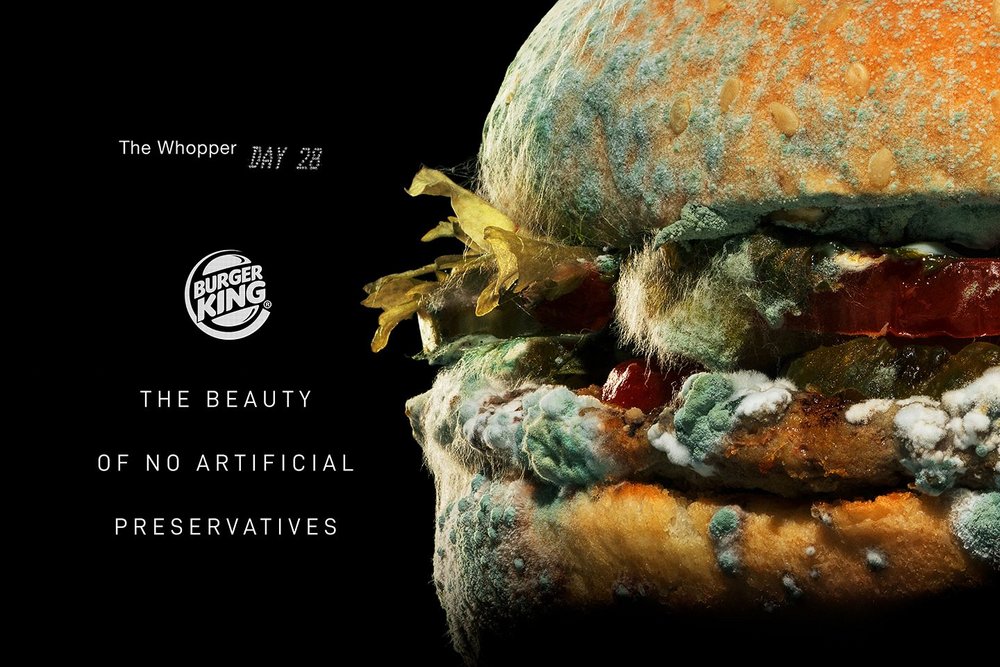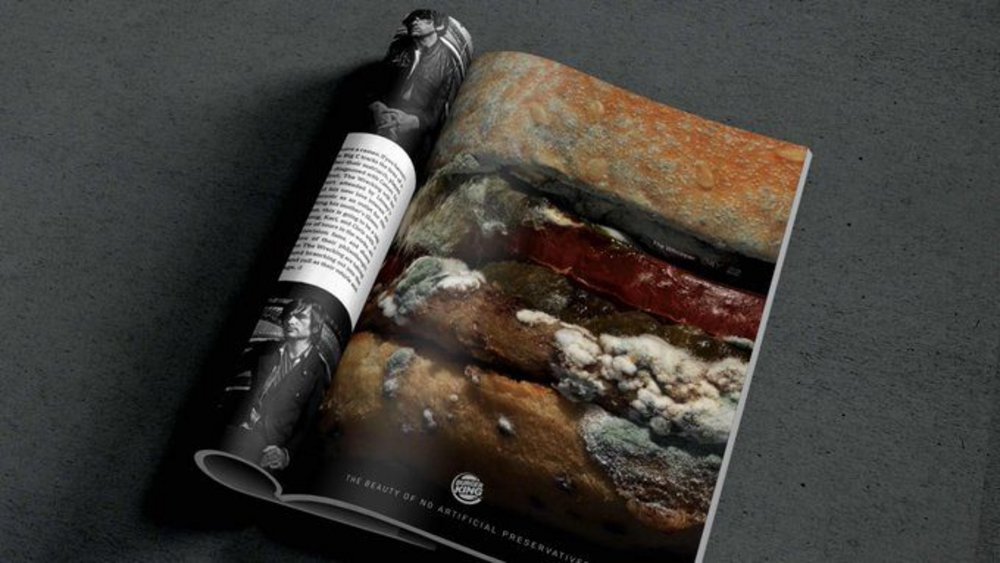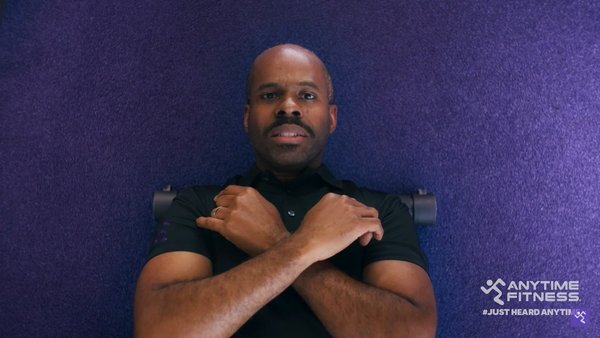For and against Burger King’s Moldy Whopper ad /
Burger King’s mould ad has split opinion; two Contagious strategists argue to split it even further

Burger King’s mouldy whopper ad, which shows the fast food chain’s hero product in a state of disgusting decomposition, has divided marketers and agency folk, and it’s divided Contagious, too.
The rationale for the global ad campaign is sound enough. Burger King is (gradually and at different speeds in different places) removing artificial preservatives from its Whopper sandwiches across Europe and the US and the ads demonstrate what happens to a normal, natural food product when it is left to rot.
The decay is portrayed as a kind of beauty, in stark contrast to the McDonald’s meal in Iceland that has hardly deteriorated, even 10 years after it was purchased.
But the campaign, which was created by three agencies working together (Ingo, David and Publicis) has split opinion. Essentially, it all comes down to whether the ad will be a triumph in the same vein as Volkswagen’s Lemon, or a self-inflicted disaster like (allegedly) You’re Never Alone With A Strand. But there’s a fascinating diversity of paths leading people to one of those two positions.
While some claim that the campaign is brave and bold, others dismiss it as a cynical ploy to impress awards juries and doubt that it will be seen by anyone in the real world.
While some think it’s a powerful and distinctive message that will cut through the noise, others are equally convinced the ads create an unappetising association between Burger King and fungus.
Part of the problem is that we’re arguing about this too soon: we don’t know enough about the media plan and it’s far, far too soon to start measuring what impact the ads have had.
But Contagious exists to assess commercial creativity and there was no way that we could just leave this one alone – it’s just too compelling and the unresolved tension in the office was starting to feel oppressive.
So here’s the for and against arguments by two members of Contagious’ advisory team.

For, by James Womersley, senior strategist /
I was fully prepared to dislike this campaign when an article about it showed up in my news feed. My overriding reaction was one of fatigue – here was, no doubt, another act of aggressive provocation from an industry that too often prioritises short-term PR spikes over the building of robust platforms for profitable growth.
I also don’t think that I’m overly prone to bouts of rabid and unmerited enthusiasm for campaigns. Instances of genuinely exciting work are, sadly, relatively rare.
But I really really really like this campaign and here’s why.
‘If your advertising goes unnoticed, everything else is academic’ – Bill Bernbach
There’s a reason why Bernbach is still quoted 37 years after his death. He knew a thing or two about effective communication.
The reality is that getting attention is the sine qua non of our industry. You can have all the targeting trickery and fluent branding you like, but if it doesn’t get noticed then it’s a waste. And that imperative is more pressing than ever. Marketing expert Ron Marshall predicts that the modern consumer is exposed to between 4,000 and 10,000 adverts per day. The battle for attention is real.
The Moldy Whopper is the most attention-grabbing thing I have seen for a long time. It is a visceral gut-punch of an ad that forces you to sit up and take notice, serving you up a thick slice of cognitive dissonance. It is what Karen Nelson-Field would describe as ‘high-arousal content’. High-arousal content is remembered around three times more than low-arousal content.
But just getting attention isn’t enough.
‘If all you want to do is attract attention, put a gorilla in a jockstrap’ – David Ogilvy
Wise words from another advertising luminary. Grabbing attention is, importantly, a means to an end not an end in itself.
The Moldy Whopper leverages ‘norm violations’ which typically drive attention, recall and recognition (Dahl, Frankenberger & Manshandra, 2003). However, these norm violations can backfire if they are handled clumsily: if they sow cognitive dissonance without providing cognitive resolution.
Now the nay-sayers will argue that this campaign is pure provocation and that the residual mental image is of rotten Burger King food.
I disagree.
Leon Festinger’s famous research showed how human beings resist cognitive dissonance and strive to resolve it. In the case of Burger King, mould is instinctively alarming and we don’t expect to see it in an advert, which causes psychological discomfort. The desired resolution is provided by the clear message of freshness. The cleverness of the ad lies in how it provokes initial disgust but ultimately effects a positive appraisal of the product: Burger King burgers are natural, not pumped full of preservatives.
This is the type of provocative, psychologically astute, visually enticing creative that we should celebrate.

Against, by Dan Southern, strategy director /
Right. I’m going to do the exact thing that Mr Machado [Fernando, Burger King’s global CMO] wants me to do with his ad: question its merits.
Because the fact that I’m debating its merits, means that it got noticed. That it had impact to the point that it got talked about and achieved fame on some level. And it’s hard to argue there being any downsides to this when, speaking after his Most Contagious appearance in New York recently, Machado said: ‘Failure most often equals “nothing happens’’’ meaning no sales increase, no shift in brand attributes.
His strategy for running with controversial – some say stunt-y – ideas is also one that not everyone is a fan of (usually marketers with How Brands Grow tattoos). These are ideas, they say, that speak too much to adland.
I, however, am a fan of the BK approach. Up against the clout of McDonald’s, I wonder what the detractors would have Burger King do? Sit back and run taste tests?
That all said, I’m not entirely convinced that you can have your 34-day old mouldy Whopper and eat it, with license to do anything you want to achieve fame.
To me, this idea, appealing on more than a visceral level with its message about food quality, might seed some nagging questions.
They were putting a ton of preservatives in their burgers? What else do they put in there? I don’t mind joining the queue at Greggs actually, do you?
Like the way we think? Contagious members get access to our online intelligence tool, I/O, which is packed with case studies and in-depth interviews, and a whole lot more. Find out more about Contagious membership here.
Want more of the same? /
We don’t just write about best-in-class campaigns, interviews and trends. Our Members also receive access to briefings, online training, webinars, live events and much more.







